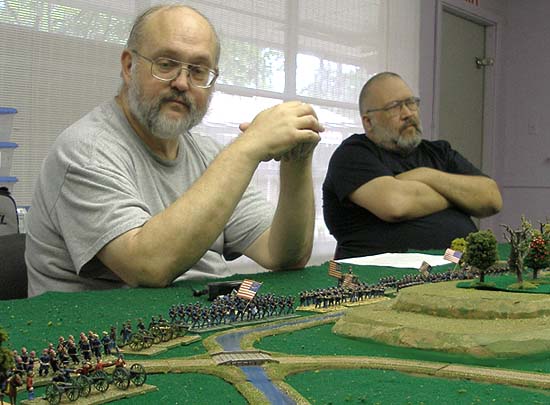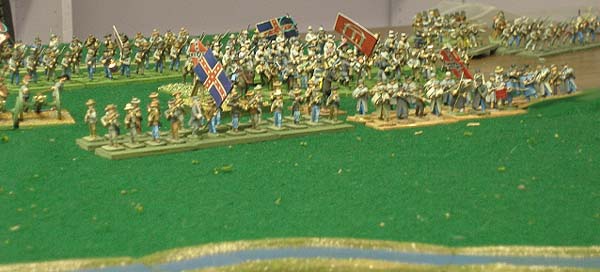

Jackson Gamers' 1863 battle in 25mm
Using our Crossing the Deadly Ground rules.
Across the open ground

Photo by Jim Pitts
The empty table, just after the terrain has been set up. We should have had more terrain, and less open space. Ed Sansing is seated to left, on what became the Confederate left flank. Jay Stribling (the Game-master) stands on the right of the table at the center where his Second Union Division defended. This was a flat battlefield with only one hill.
This game took place on July 21, 2007 in a classroom at SOUTHWEST ACADEMY in Jackson MS. In this game, we used a rules set that we used to call the "continuous fire-fight" rules. The game was supposed to begin at 10am but this was a large army to set up and with some tutorials about the rules - which we had not played in several years - the fighting began at around 11:00am. We took a lunch break at 1:00pm and then resumed played till 3:30pm.
The Rebel players were: (left flank to right flank) - Sean Pitts, Phil Young, Robert Whitfield and Ed Sansing. The Union players were: (right flank to left flank) - Jim Pitts, Jay Stribling and Fred Diamond.
The Federal forces were set up on the board awaiting the southern attack. The Confederates moved onto the battlefield and advanced toward the enemy. They were under artillery fire immediately and came under rifled musketry on turn two.

Photo by Jim Pitts
The forces shown were those of the Union First Division, under the command of Jim Pitts. These formed the Federal right flank.
One of the reasons that we played this game at SOUTHWEST ACADEMY was that we could set up a 16' long table there. When we set the game up, we found that our ground cloth was only 12' long, so our battlefield was 12' wide and 6" in depth. In many of our previous games at HOBBYTOWN, we had too many troops for our table. We used MOST (not all) of the ACW armies of Robert Whitifield and Jay Stribling in this game. The forces were a comfortable fit on a 12' gaming area.

Photo by Jim Pitts
Jay Stribling (on left) surveys his troops. He set up behind a small stream and across the stream was the only high ground on the field. His troops moved sluggishly to occupy the hill, taking 3 turns (and a free move) to do so. Stribling's Second Division formed the center of the Union Line.
Fred Diamond (in black shirt) was the overall Union commander and his Third Division formed the Federal Left.
What were the opposing forces?
The Rebel army (commanded by James Longstreet) consisted of 10 brigades organized into three divisions. The Brigades each had three or four regiments of 24 minature infantrymen each. This is around 820 castings of infantry, supported by 40 artillerymen manning 20 miniature artillery pieces.
The Union army (commanded by Winfield Scott Hancock) consisted of 7 brigades, also organized into three divisions. The Brigades each had three or four regiments of 24 minature infantrymen each. This is around 552 castings of infantry, supported by 42 artillerymen manning 21 miniature artillery pieces. Two further brigades totalling seven regiments of infantry came on near the end of the fighting, adding 168 more infantry castings to the defenders.

Photo by Jim Pitts
This photo shows part of a Division of Rebel infantry commanded by Phil Young the left center of the Confederate line. He was mainly with Stribling's Union Second Division. Young's men eventually took the hill defended by Stribling, but could not advance beyond it.

Photo by Jim Pitts
Note the Yellow/gold morale rating ring on the flag of the closest Union infantry regiment. A unit's morale rating is unknown in these rules, until it has "seen the elephant." Once it has come under enemy fire and had to test morale, it's morale rating will be shown by the presence of a green (2 points), blue (3 points) or gold (4 points) ring placed on the standard. This unit is a gold (as good as it getes) but has already lost half of its' strength. The Zouaves in the woods next to this unit also have been shot up, but not quite so severely.
As this front line brigade of Jim Pitts' troops got shot to pieces by Sean Pitts's advancing Rebel division, Jim began to move his reserve brigade over behind them. The reserve brigade would eventually assume responsibility for the extreme right of the Union line and hold it until darkness fell.
Note that this is an all-too-typical happening in the American Civil War, where the father (Jim Pitts) and the son (Sean Pitts) served on different sides in the conflict!

Photo by Jim Pitts
Part of Sean Pitts' Rebel division advances very slowly on the left of the Confederate battle line.
There was no cavalry in either army. Presumably they had been used for pre-battle scouting and for guarding the flanks of both armies.

Photo by Jim Pitts
Phil Young's Rebel division slowly advances across the open fields toward the hill in the center of the Union lines.

Photo by Jim Pitts
The hill is defended by one of Jay Stribling's brigades. Phil's infantry shot this brigade to pieces, forcing them back off the hill onto the reverse slope. Three times the Federal troops reoccupied the hill, till finally they let the Rebels have it.

Photo by Jim Pitts
One of Phil Young's brigades finally gains the hill in the Union center after they had shot Stribling's defending brigade to pieces. But when the crested the hill, they discovered a fresh reserve brigade of four regiments deployed in the rear of the hill. Night fell before Phil could consolidate his gains.

Photo by Jim Pitts
The center of Jim's division which was under very little Rebel pressure throughout the battle. Almost all his losses here came from Rebel artillery fire.

Photo by Jim Pitts
The left on Jim's line was held by Berdan's sharpshooters in the patch of woods, with one regiment to their left (picture's right) and one regiment in support to the rear of the woods. The artillery battery that was to the immediate left of the woods was damaged and forced back by the weight of the Rebel batteries' shells and eventually was withdrawn from the battlefield.

Photo by Jim Pitts
Three of the Rebel commanders - Ed Sansing, Robert Whitfield, and Phil Young - ponder their force deployments and wonder whether they have the power to break through the Union lines. They didn't!

Photo by Jim Pitts
Phil Young's Rebel troops, with some of Robert Whitfield's in the background, continue to slowly advance towards the hill. Ed Sansing and Robert Whitfield jointly commanded an oversized Confederate division on the Rebel's right flank. Most of their attacks went against Fred Diamond's Union 3rd division.
Due to Fred's fire, the Confederate right eventually flinched and moved slightly to the left, coming in against the joint between Stribling's Secnd Federal division, and Fred Diamonds's Third divison. They were unable to make any progress here.

Photo by Jim Pitts
The center and left of Jim's division fire on the opposing Rebels, preventing them from making any significant progress in this part of the battlefield.

Photo by Jim Pitts
One of Sean's brigades cowers in the woods after being shot-up by Jim's artillery and the sharpshooters of Berdan's regiment. Sean finally began moving his last brigade (of four or five) around the woods towards Jim's lines but they didn't close before night fell.
Sean Pitts had a very large Rebel division and had the majority of the fresh Southern troops at the end of the game. He had made very little progress in coming to grips with the Federal Right, partly due to poor command control dice. If he had pressed forward more vigorously, it is possible that Jim Pitts would have been forced to the left, and crowded up against Stribling's Union Second division. This would have come close to uncovering one of the roads to the Union rear, which was a "must hold" for the Northerners and a "must take" for the Southerners.
SO - Who won this battle?
The result was that the Union held. The Rebels victory conditions were to move units across the board and to exit them into the enemy rear on either or both of two roads, and (of course) to kill Yankees. Both sides had about the same numbers of regiments or batteries destroyed or driven from the field. The Confederates lost 13 infantry regiments or artillery batteries and the Northern forces lost 12 unit. However, the Union army still held the roads leading to their rear. It was decided that the Yankees won.
Return to the Master Index of Photos and Games
Return to the Jackson Gamers' Homepage
Angelfire - Free Home Pages
Free Web Building Help
Angelfire HTML Library
htmlGEAR - free polls, guestbooks, and more!
Thank you for visiting The Jackson Gamers' pages at Angelfire. Please come back and visit again!